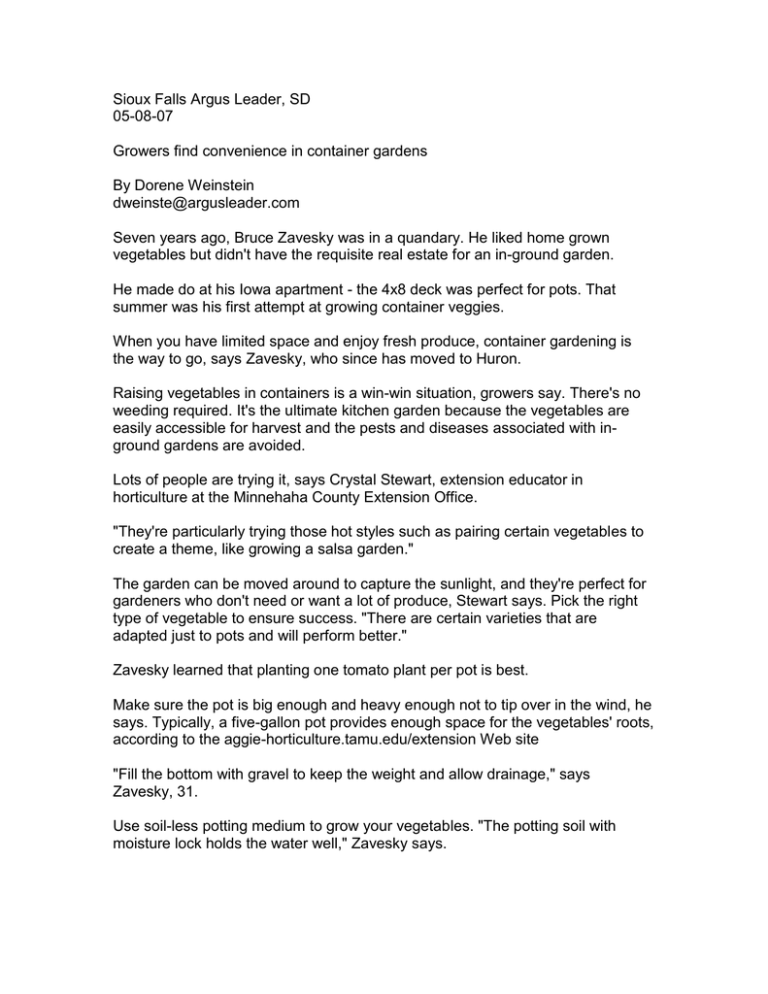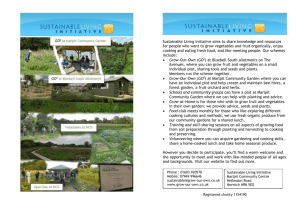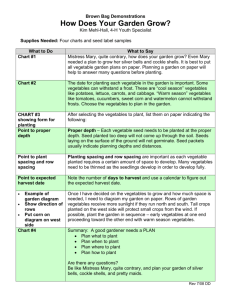Sioux Falls Argus Leader, SD 05-08-07 Growers find convenience in container gardens
advertisement

Sioux Falls Argus Leader, SD 05-08-07 Growers find convenience in container gardens By Dorene Weinstein dweinste@argusleader.com Seven years ago, Bruce Zavesky was in a quandary. He liked home grown vegetables but didn't have the requisite real estate for an in-ground garden. He made do at his Iowa apartment - the 4x8 deck was perfect for pots. That summer was his first attempt at growing container veggies. When you have limited space and enjoy fresh produce, container gardening is the way to go, says Zavesky, who since has moved to Huron. Raising vegetables in containers is a win-win situation, growers say. There's no weeding required. It's the ultimate kitchen garden because the vegetables are easily accessible for harvest and the pests and diseases associated with inground gardens are avoided. Lots of people are trying it, says Crystal Stewart, extension educator in horticulture at the Minnehaha County Extension Office. "They're particularly trying those hot styles such as pairing certain vegetables to create a theme, like growing a salsa garden." The garden can be moved around to capture the sunlight, and they're perfect for gardeners who don't need or want a lot of produce, Stewart says. Pick the right type of vegetable to ensure success. "There are certain varieties that are adapted just to pots and will perform better." Zavesky learned that planting one tomato plant per pot is best. Make sure the pot is big enough and heavy enough not to tip over in the wind, he says. Typically, a five-gallon pot provides enough space for the vegetables' roots, according to the aggie-horticulture.tamu.edu/extension Web site "Fill the bottom with gravel to keep the weight and allow drainage," says Zavesky, 31. Use soil-less potting medium to grow your vegetables. "The potting soil with moisture lock holds the water well," Zavesky says. Keep the pots watered. Containers dry out quicker in the sun and wind than an in-ground garden. "Tomatoes have a huge root system; if you put them in a too-small container, you run into water problems," Stewart says. Tomatoes require a lot more water than you think, Zavesky says. "When they're bearing fruit, you'll have to water them twice a day," he says. Water enough so that water gets to the bottom of the pot and drains out the holes. Keeping them evenly moist will help prevent blossom end rot that occurs when water is provided in a feast or famine fashion, says local gardener Mary Ellen Connelly. Stake the tomato and put on the cage before the plant gets too rangy to give it support, Zavesky says. Prune the plant so that it's down to one or two stems to make it manageable. Next, pinch out the shoots that form at the axils where the leaves and stems join. Larry Zavesky, Bruce's dad, says home gardeners should buy "determinant tomatoes" for container gardens. "They get to a certain stage, make their tomatoes and stop growing." Containers need more fertilizing than in-ground gardens because nutrients are used up quickly or leached out with watering. The Iowa State University Extension Web site recommends fertilizing weekly with a liquid fertilizer. Position the pots in a sunny spot, preferably one that gets six hours of sunlight a day. Some vegetables, such as lettuce, cabbage, greens, spinach and parsley, can tolerate more shade. Rotate crops just as you would for an in-ground plot, Stewart says. Or switch out the potting soil every year. Follow the spacing directions on the seed packages, Stewart says. The recommended space is for light and air circulation needs and shouldn't be reduced. This year, Zavesky sewed his peppers in March. When the time is right, he'll move the pots outside and harvest the peppers when they're ripe. When it gets cold in the fall, he will move them back inside. "We'll have peppers all winter, too." Reach Dorene Weinstein at 331-2315.




